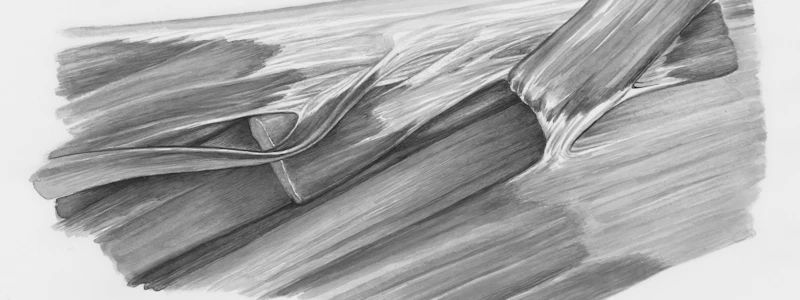Podcast
Questions and Answers
What is the largest division of the brain?
What is the largest division of the brain?
- Brain Stem
- Cerebrum (correct)
- Cerebellum
- Diencephalon
What is the function of the thalamus?
What is the function of the thalamus?
Relay station for sensory information.
What do sulci (sulcus) refer to?
What do sulci (sulcus) refer to?
Grooves on the surface of the brain.
The hypothalamus regulates vital activities such as blood pressure and respiration.
The hypothalamus regulates vital activities such as blood pressure and respiration.
The brainstem consists of _____ parts.
The brainstem consists of _____ parts.
What is the function of the cerebellum?
What is the function of the cerebellum?
Which structure connects the two cerebral hemispheres?
Which structure connects the two cerebral hemispheres?
What does the white matter consist of?
What does the white matter consist of?
The medulla oblongata controls voluntary movements.
The medulla oblongata controls voluntary movements.
Match the following nervous system terms with their definitions:
Match the following nervous system terms with their definitions:
What is the function of the spinal cord?
What is the function of the spinal cord?
Which layer of the meninges is the outermost and toughest?
Which layer of the meninges is the outermost and toughest?
The _____ contains cerebral spinal fluid (CSF) and cushions the CNS.
The _____ contains cerebral spinal fluid (CSF) and cushions the CNS.
What is the role of the blood-brain barrier?
What is the role of the blood-brain barrier?
Reflex actions are always conscious decisions.
Reflex actions are always conscious decisions.
Flashcards are hidden until you start studying
Study Notes
Major Brain Structures
- Cerebrum: Largest brain division, divided into two halves and four lobes.
- Frontal Lobe: Responsible for motor areas that control conscious body movements.
- Temporal Lobe: Involved in auditory areas for sound interpretation.
- Occipital Lobe: Visual processing center interpreting sights.
- Parietal Lobe: Somatosensory areas interpreting sensations like touch.
- Cerebellum: Coordinates complex skeletal muscle contractions for precise movements.
- Brain Stem: Connects cerebrum to spinal cord with three parts; regulates vital functions.
- Diencephalon: Integrates sensory information and includes the thalamus and hypothalamus.
Key Components of the Spinal Cord
- Spinal Cord: Continuous with the brain, descends through the vertebral canal, ending at L1-L3 vertebrae.
- Gray Matter: Inner spinal cord area containing neuron cell bodies and dendrites.
- White Matter: Outer spinal cord area with myelinated axons, organized into nerve tracts.
- Central Canal: Runs the length of the spinal cord, containing cerebrospinal fluid (CSF).
- Cervical & Lumbar Enlargements: Thicker portions of the spinal cord that contain motor neurons for arm and leg muscles.
Functional Structures
- Corpus Callosum: Connects the two cerebral hemispheres, facilitating inter-hemispheric communication.
- Thalamus: Relay station for sensory information heading to the cerebral cortex.
- Hypothalamus: Regulates homeostasis and vital functions like blood pressure and hormone levels.
- Pituitary Gland: Master gland regulating hormones and various body functions.
Spinal Nerves and Reflexes
- Withdrawal Reflex: Automatic response pulling away from harmful stimuli.
- Reflex Arc Sequence: Pathway from stimulus to receptors, sensory neurons, interneurons, motor neurons, and effectors.
- Cranial Nerves: Peripheral nerves originating from the brain, involved in various sensory and motor functions.
Membranes and Protective Layers
- Meninges: Three protective membrane layers around the CNS.
- Dura Mater: Outermost layer, tough and protective.
- Arachnoid Mater: Middle, wispy layer.
- Subarachnoid Space: Contains CSF to cushion the CNS and protect against injury.
- Blood-Brain Barrier: Protective capillary network restricting substance entry into the CNS.
Brain Ventricles and CSF
- Ventricles: Interconnected cavities within the brain filled with CSF.
- CSF Functions: Protects, cushions, and maintains homeostasis within the CNS.
Other Key Concepts
- Gyri and Sulci: Gyri are the bumps, while sulci are the grooves on the brain's surface, increasing cortical surface area.
- Nervous Tissue Appearance: Gray and white matter visible in cross-sections of the brain and spinal cord.
Studying That Suits You
Use AI to generate personalized quizzes and flashcards to suit your learning preferences.




